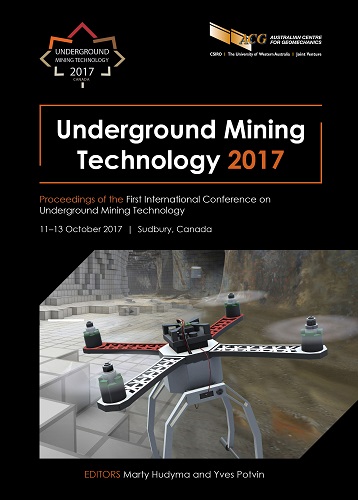Variations in apparent stress and energy index as indicators of stress and yielding around excavations

|
Authors: Carusone, O; Hudyma, M |
DOI https://doi.org/10.36487/ACG_rep/1710_16_Carusone
Cite As:
Carusone, O & Hudyma, M 2017, 'Variations in apparent stress and energy index as indicators of stress and yielding around excavations', in M Hudyma & Y Potvin (eds), UMT 2017: Proceedings of the First International Conference on Underground Mining Technology, Australian Centre for Geomechanics, Perth, pp. 205-218, https://doi.org/10.36487/ACG_rep/1710_16_Carusone
Abstract:
Analysis of source parameters of microseismic events provides useful information about the rock mass response to mining. Energy index and apparent stress are source parameters that quantify relative coseismic stress adjustment. Trends in these parameters might show how mining-induced stresses change in the initial hours after a blast. Analysis of events following production blasts in a deep open stoping operation suggests that the rock mass undergoes a rapid stress increase immediately after the blast, followed by some degree of more gradual yielding. These responses vary between different stope blasts and spatially around a stope. These results may also vary with local conditions such as rock mass properties and stoping geometry.
Keywords: seismic monitoring, rock mass response
References:
Alcott, JM, Kaiser, PK & Simser, BP 1998, ‘Use of microseismic source parameters for rockburst hazard assessment’, Pure and Applied Geophysics, vol. 153, no. 1, pp. 41–65.
Aki, K & Richards, PG 1980, Quantitative Seismology: Theory and Methods, Freeman, San Francisco.
Brown, LG 2015, Seismic Hazard Evaluation Using Apparent Stress Ratio for Mining-Induced Seismic Events, MSc Thesis, Laurentian University, Sudbury.
Brown, L & Hudyma, M 2017a, ‘Identification of stress change within a rock mass through apparent stress of local seismic events’, Rock Mechanics and Rock Engineering, vol. 50, no. 1, pp. 81–88.
Brown, L & Hudyma, M 2017b, ‘Identifying local stress increase using a relative apparent stress ratio for populations of mininginduced seismic events’, Canadian Geotechnical Journal, vol. 54, no. 1, pp. 128–137.
Glazer, SN & Hepworth N 2006, ‘Crown pillar failure mechanism – case study based on seismic data from Palabora Mine’, Mining Technology: Transactions of the Institutions of Mining and Metallurgy: Section A, vol. 115, no. 2, pp. 75–84.
Harris, PC & Wesseloo J 2015, mXrap, version 5, Australian Centre for Geomechanics, Perth, viewed 7 July 2017,
Hudyma, MR 2008, Analysis and Interpretation of Clusters of Seismic Events in Mines, PhD Thesis, The University of Western Australia, Perth.
Hudyma, MR, Potvin, Y, Grant, DR, Milne, D, Brummer, RK & Board, M 1994, ‘Geomechanics of sill pillar mining’, in PP Nelson & SE Laubach (eds), Proceedings of the 1st North American Rock Mechanics Symposium, A.A. Balkema, Rotterdam,
pp. 969–976.
Ide, S & Beroza, GC 2001, ‘Does apparent stress vary with earthquake size?’, Geohpysical Research Letters, vol. 28, no. 17, pp. 3349–3352.
King, GCP, Stein, RS & Lin, J 1994, ‘Static stress changes and the triggering of earthquakes’, Bulletin of the Seismological Society of America, vol. 84, no. 3, pp. 935–953.
Mendecki, AJ, van Aswegen, G & Mountfort, P 1999, ‘A guide to routine seismic monitoring in mines’, in AJ Jager & JA Ryder (eds), A Handbook on Rock Engineering Practice for Tabular Hard Rock Mines, Creda Communications, Cape Town.
Orlecka-Sikora, B 2010, ‘The role of static stress transfer in mining induced seismic events occurrence, a case study of the Rudna mine in the Legnica-Glogow Copper District in Poland’, Geophysical Journal International, vol. 182, no. 2, pp. 1087–1095.
Simser, B & Falmagne, V 2004, ‘Seismic source parameters used to monitor rockmass response at Brunswick mine’, CIM Bulletin, vol. 97, no. 1080, pp. 58–63.
Syrek, B & Kijko, A 1988, ‘Energy and frequency distribution of mining tremors and their relation to rockburst hazard in the Wujek coal mine, Poland’, Acta Geophysica Poland, vol. 36, no. 3, pp. 189–201.
Urbancic, TI, Trifu, C-I, Long, JM & Young, RP 1992, ‘Space-time correlations of b-values with stress release’, Pure and Applied Geophysics, vol. 139, no. 3–4, pp. 449–462.
van Aswegen, G & Butler, AG 1993, ‘Applications of quantitative seismology in South African gold mines’, in RP Young (ed.), Proceedings of the 3rd International Symposium on Rockbursts and Seismicity in Mines, A.A. Balkema, Rotterdam,
pp. 261–266.
Wesseloo, J, Woodward, KR & Pereira, J 2014, ‘Grid-based analysis of seismic data’, Journal of The South African Institute of Mining and Metallurgy, vol. 114, no. 10, pp. 815–822.
Wyss, M & Brune, JN 1968, ‘Seismic moment, stress, and source dimensions for earthquakes in the California-Nevada Region’, Journal of Geophysical Research, vol. 73, no. 14, pp. 4681–4694.
Young, DP 2012, Energy Variations in Mining-Induced Seismic Events Using Apparent Stress, MSc Thesis, Laurentian University, Sudbury.
© Copyright 2025, Australian Centre for Geomechanics (ACG), The University of Western Australia. All rights reserved.
View copyright/legal information
Please direct any queries or error reports to repository-acg@uwa.edu.au
View copyright/legal information
Please direct any queries or error reports to repository-acg@uwa.edu.au